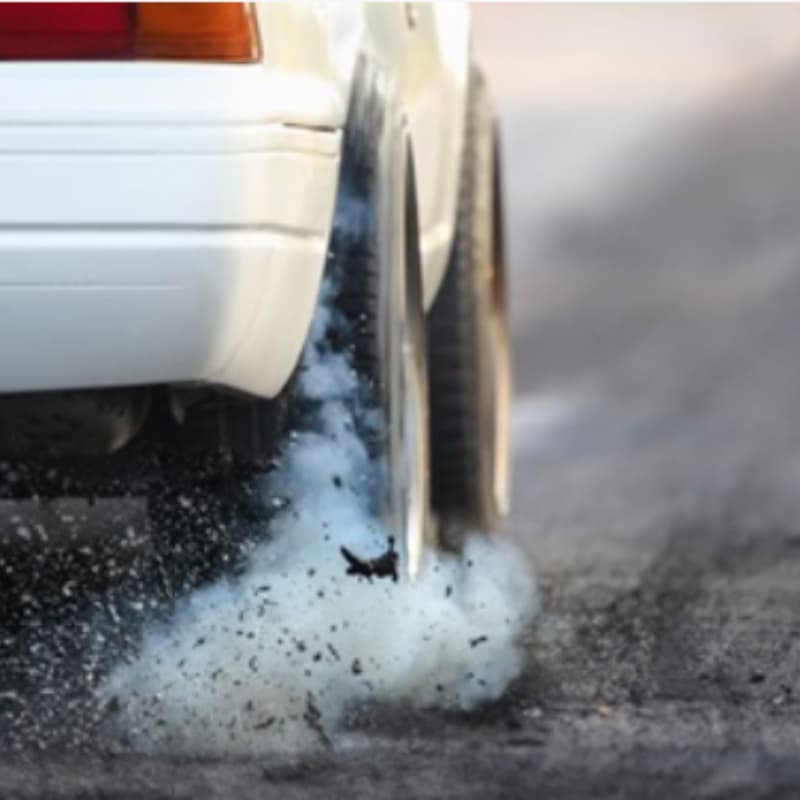In the debate on air pollution, many people naturally blame factory emissions, exhaust fumes from internal combustion vehicles, and the burning of fossil fuels for urban heating or electricity production as the primary culprits. However, according to a British study, a significant source of pollution, largely unknown to the general public, lies in the daily wear of our vehicle tires. In fact, our tires emit more particulate matter than gasoline engines! So, what are these fine particles from tire wear that accumulate in our environment? What is their impact on our health and the planet? And how can we effectively protect ourselves from tire particulate pollution?
Very harmful tire particles
Car tires are made of various materials, including rubber, metals and plasticizers, which, when worn by friction with the asphalt, release fine particles in the air.
According to Emissions Analytics*, they would in fact be up to 2000 times more toxic than the exhaust gases which make up the Nitrogen dioxide ! According to this organization, a new tire emits up to 73mg of fine particles per kilometer when a thermal engine releases into the atmosphere about 0.02 mg/km. Tire particles have therefore become the primary source of fine particles along with brake particles linked to brake pad wear. On a global scale, millions of tons of rubber and other carcinogenic chemicals are released each year into the air we breathe.
What is worrying is that electric vehicles, which are supposed to be the solution to air pollution in cities, are also equipped with tires and brake pads. Since they are on average 25% heavier than combustion engine vehicles, their tires will wear out faster. Their braking systems, on the other hand, release fewer particles because electric vehicles slow down mainly with the engine to recover energy. The problem of automobile pollution therefore only seems to be partially solved.
These particles can penetrate deep into the lungs and, according to some studies, carry pollutants that accumulate in our bodies over time. Prolonged exposure to these particles can contribute to health problems such as respiratory diseases, cardiovascular diseases and even some cancers.
Micro particles of tires are present everywhere
The ubiquitous presence of vehicles makes tire pollution a global environmental problem, affecting both densely populated urban areas and more isolated regions. Winds sweep cities clean and pollute the countryside with these invisible elements.
Unfortunately, the particles do not remain suspended in the air: they eventually end up in water and soil, affecting flora and fauna. They contribute to global plastic pollution of the oceans and the food chain.
Exposure to tire particles largely depends on our lifestyle habits and our environment. Living near major highways, engaging in outdoor activities in high traffic areas, or frequently using your vehicle can significantly increase our exposure. Being aware of these factors is the first step toward reducing our personal exposure.
What are the particle protection strategies?
Choice of alternative routes: Favoring less polluting modes of transport such as cycling, walking or public transport can reduce our personal contribution to tire pollution and our exposure to particles.
Vehicle maintenance: Regular maintenance and checking tire pressure can reduce wear and therefore the amount of particles emitted. Choosing tires designed for less wear and better environmental efficiency can also make a difference.
Individual preventive measures: Use air purifiers equipped with a HEPA filter at home and in the office. In areas with high pollution, when traveling by motorbike or bicycle in the middle of traffic, wearing a filter mask can also provide additional protection.
Does a face mask protect against tire particles?
There are many types of respiratory masks. The most suitable for protecting against fine pollution particles are anti-pollution masks.
Frogmask's have been designed to protect cyclists and motorcyclists from airborne particles while riding through traffic. This is where the pollution concentration is highest. Their FFP2/N95 filters block at least 94% of particles up to 0.4µm.
They are perfect for blocking PM10 particles and PM2.5 and therefore up to PM0.4.
What are the initiatives to reduce emissions?
Everyone can take action every day by adopting a more economical driving style for the tires. Shift into high gear as soon as possible, drive at a constant speed rather than jerkily, avoid excessive speeds, sudden starts, burnouts and donuts.
Several European governments, aware of the threat that could become as embarrassing as the asbestos crisis of the 80s/90s, are asking manufacturers to work on less polluting tires and, in the meantime, to work on measuring tire particle emissions.
The French brand Michelin has launched a major study on reducing tire wear in 2023, and has created a joint laboratory for the occasion in partnership with the CNRS and the University of Clermont Auvergne. The aim is to better understand these microparticles known as PM10 (size less than 10 µm). At the end of March 2024, the engineers presented to the Tire Technology Expo (Hannover Tyre World Fair), a system for collecting and analyzing tire residues to help design stronger, less polluting tires.
There Euro 7 standard, created in 1992 to reduce particle emissions linked to the combustion of fossil fuels, to which we owe the catalytic converter or the upcoming ban on diesel, will integrate particle emissions from tires. Brands that do not meet the new standards will no longer be able to market their products.
Tire particulate pollution is a complex issue that requires awareness and action at all levels. By adopting responsible behaviors, supporting community initiatives, and advocating for strong public policies, we can all do our part to reduce our exposure to these harmful particles and protect our health and the environment. The road to cleaner air and a more sustainable future is paved with small, everyday actions, and every action counts.
* Emissions Analytics is a leading company specializing in real-world emissions testing and analysis. They provide insights into tailpipe emissions, tire wear, vehicle interior air quality, and fuel impacts. Using advanced equipment, they measure emissions from light and heavy-duty vehicles, as well as off-road machinery, and provide consulting services. Their research supports market analysis, regulatory compliance, and product development, aimed at improving environmental and public health outcomes.








